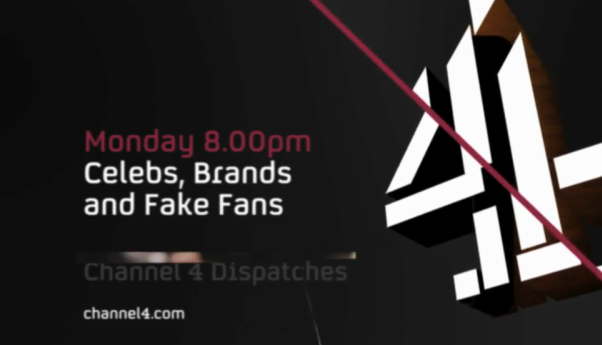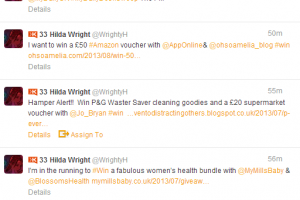How many of the FTSE 100 Twitter accounts have Fake Followers?
 Social Media
Social Media Following Channel 4’s Dispatches programme last night about the practice of fake Facebook Likes and Twitter followers, we decided to update our FTSE 100 companies on Twitter list and to see which brands have the highest amount of fake Twitter followers.
Using the simple to use fake Twitter follower tool from StatusPeople.com, we looked at the top 10 FTSE 100 companies, and had a look to see which of these accounts had fake followers. As with all things, these are the figures that the StatusPeople.com website revealed - so these stats are only as good as the platform.
Top 10 FTSE 100 Twitter accounts
| NAME | FOLLOWERS | FAKE | INACTIVE | GOOD | ||
| 1 | British Airways | @british_airways | 286,553 | 15% | 37% | 48% |
| 2 | Marks & Spencers | @marksandspencer | 238,215 | 10% | 34% | 46% |
| 3 | Royal Dutch Shell | @shell | 177,198 | 17% | 46% | 37% |
| 4 | Sainsburys | @sainsburys | 176,803 | 28% | 36% | 36% |
| 5 | Cadbury | @CadburyUK | 161,145 | 9% | 38% | 53% |
| 6 | Tesco | @uktescooffers | 107,912 | 32% | 38% | 30% |
| 7 | Carnival | @CarnivalCruise | 87,798 | 15% | 35% | 50% |
| 8 | Thomson Reuters | @thomsonreuters | 83,789 | 2% | 11% | 87% |
| 9 | Vodafone | @VodafoneUK | 81,905 | 11% | 31% | 58% |
| 10 | BP | @BP_America | 64,629 | 19% | 36% | 45% |
It is interesting to note that Tesco and Sainsbury’s lead the list in terms of fake Twitter followers, but this may be down to the fact of the accounts regularly offer discounts, competitions and offers. Usually, this type of activity attracts “professional compers” - or individuals who set up multiple Twitter accounts for the purpose of entering “Tweet to win” or “Follow to win” competitions by brands. Typically, comper accounts are easily identifiable by the fact they only tweet competitions or offers, and usually have no real name, profile picture or biography.
At the other end of the scale, Thomson Reuters had the least amount of fake Twitter followers and also the lowest amount of inactive followers, suggesting that the account is continuing to engage and build on a solid foundation.
NOTE: We intend to update this entire list later in the day but due to the Twitter API we can only retrieve a certain amount of results.
Why bother with fake followers?
While the practice of buying followers is viewed with contempt by digital marketers, there are clearly still many who view it as a preferred tactic to grow (or appear to grow) a Social Media channel. More than often than not, the excuse is that “it is a good place to start” for clients who have zero Twitter followers. The opinion is that if say 500-1000 fake followers are bought and added to the account, then the brand will be seen with more legitimacy by customers. Any Social Media manager will know that building a presence from day one requires a bit of creativity, a bit of time and a bit effort to get the ball rolling.
The benefits of this early (and often tedious) work is that you have a strong foundation and can often start developing brand advocacy from an early stage. Alternatively, many brands use Social Media competitions such as “Follow to win” as a way of inflating their numbers, but this might just attract an audience of professional compers.
Ultimately, buying fake followers is down to sheer laziness and shows that the person who buys it simply doesn’t get Social Media. No doubt last night’s programme saw Social Media bods proclaim that it is engagement, not followers that is important, and while this may be a bit cliche, it is still true (in fact, I was surprised how few even talked about conversions/sales).
Fake followers might create the illusion of a large Social Media presence, but ultimately it’s not the numbers that matter, but rather the quality of those followers and how likely they are to convert, share your content or even talk about you offline.
So have all these brands bought fake followers?
 This is an important question that last night’s programme failed to cover. It is not always necessarily the case that a brand/person has paid for fake followers, despite having a large percentage of them. Fake followers are inevitable, whoever you are. If you’ve ever had that awkward conversation with an older parent or grandparent where they ask why “HotSexyGirl499” is following them, you will know many new accounts are targeted instantly by spammers and fake accounts.
This is an important question that last night’s programme failed to cover. It is not always necessarily the case that a brand/person has paid for fake followers, despite having a large percentage of them. Fake followers are inevitable, whoever you are. If you’ve ever had that awkward conversation with an older parent or grandparent where they ask why “HotSexyGirl499” is following them, you will know many new accounts are targeted instantly by spammers and fake accounts.
So while the numbers above might have some truth to them, we shouldn’t necessarily accuse them of actively flooding their account with dummy Twitter users.
The programme also failed to discuss that for many brands and agencies, sometimes it can only be one person that adds these fake followers. One of the dangers of picking a dodgy Social Media agency is that it only takes £10 and somebody (a Social Media Manager or even an intern) to feel under pressure to get results for their client/brand. Consequently, they feel pressured into signing up to many of the fake follower services available online.
Unfortunately, the damage is done at this point and it can be difficult to undo this. This is particularly important for brands and agencies where they’ve recently taken charge of the primary account, and potentially could get the blame for something done years before (this is why at Blueclaw we always perform a Social Media Audit of the client’s Social Media accounts in order to understand the history of everything that has gone on).
In short…
Buying fake followers is a pointless and lazy tactic that will only bite you in the backside later on - whether it’s the client who finds out you’ve deceived them, a journalist doing an article on the issue or even worse, your peers who always love to catch their competitors out. There’s little value in fake followers as they are quite simply not real people, and fake people do not buy products, help generate content for you or even discuss your brand in reality - so why bother?
If you’d like to see a back history of your Social Media accounts, and learn more about your audience on the likes of Twitter, Facebook and LinkedIn, then fire across an enquiry to discuss conducting the aforementioned Social Media Audit.
